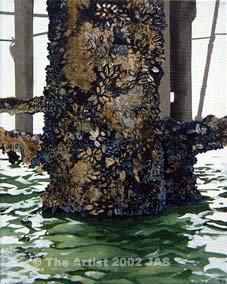Wednesday, July 26, 2006
Tuesday, July 25, 2006
NOT the Turner Prize

"Under the Pier I" was entered for the 2003 'NOT the Turner Prize' competition. The competition was a reaction against the Turner Prize which rewards often conceptual and rather controversial works. NOT the Turner Prize offered the same prize money - £20, 000 (at the time) for a realistic painting.
My painting was one of 400 out of over 10, 000 entries to be exhibited at the Mall Galleries in London. Judges included Andrew Lloyd-Webber and Ronnie Wood of the Rolling Stones. In the end "Under the Pier" recieved an award of 'highly commended' as one of the top 25 paintings.
Background
I grew up in an artistic family. For years my parents had a silk-screen painting business. My father trained as a graphic designer and my mother as a textile designer. So for me, art has always played a big part in my life.
After 6th form college I decided to continue my studies and enrolled on the art foundation course at Brighton College. Apart from the evening classes in life drawing, I felt the course was a big disappointment. I wanted to learn techniques but the tutors were more interested in getting us to produce conceptual work.
In my opinion, abstract art and conceptual art is only really justifiable and achievable if one has already studied the basics. A true artist should be technically competent before embarking on a work. Unfortunately, in contemporary British culture, the critics often deem artists to be people who produce intellectual and often controversial pieces, that lack any perceivable technical ability. I think a true work of art should incorporate both concept and technical ability. If a work is purely conceptual, then I would describe this as visual philosophy. If it is solely the execution of a brilliant technician then this is craft.
An example of a true artist would be Picasso. His early work demonstrated exceptional talent. His observational drawings and paintings were stunning, as was his use of colour and composition. Anyone familiar with his later works will know they were very different. In fact, Picasso experimented with everything. From Realism, to cubism, to abstraction. He employed all sorts of mediums and techniques in painting as well as sculpture and sometimes even incorporating them both.
Although I would love to get into a critique on Picasso, the point that I want to make is that he was justified in producing crude, abstract, child-like painting at the end of his career because it was a natural progression. By nature, an abstraction is a series of steps away from reality. Picasso began his career by painting realistically and then gradually evolved (or devolved) into painting abstractly, and as his creations changed, so did his philosophies.
The paintings I produced at the end of my foundation year can be seen above. I was pretty much the only person on the whole course out of two hundred students, who chose to paint realistically. At my final assessment, my tutors asked me why I had wasted my time painting? Needless to say this put me off continuing my artistic education. I did not want to spend a further three years fighting with my tutors. Instead I chose to study philosophy - my other great love.
Between the art foundation course and the start of my philosophy degree, I took a gap year. In that time 'Under the pier I' won an award in the NOT the Turner Prize competition, sponsored by the Daily Mail. At the private view in the Mall Galleries, London I was told that the judges had deliberated for some time about my painting. It almost made it into the runners-up category. This was incredibly encouraging for me.
During my gap year I moved to Florence, Italy. There I met an American art student who was studying at one of the art academies. He invited me to their end of year show. The work was amazing. They were all highly realistic paintings which exhibited the use of classical techniques and compositions. The course was extremely rigorous. In the first year, students worked only in black and white from plaster casts of figures, focusing mainly on tone and form. In the second year, they would study anatomy and still life and only in the final year could they touch paint. This was the complete opposite to the 'artistic training' on offer in Britain. This was what I wanted.
Unfortunately, I have not produced much work in the last four years because I had to dedicate so much time to my degree. After graduating I moved to Tokyo, Japan, which proved to be very stimulating. In fact it has inspired me to start on a new series of paintings based on modern, urban architecture, which will be appearing on this blog sometime in the near future - so watch this space.
After 6th form college I decided to continue my studies and enrolled on the art foundation course at Brighton College. Apart from the evening classes in life drawing, I felt the course was a big disappointment. I wanted to learn techniques but the tutors were more interested in getting us to produce conceptual work.
In my opinion, abstract art and conceptual art is only really justifiable and achievable if one has already studied the basics. A true artist should be technically competent before embarking on a work. Unfortunately, in contemporary British culture, the critics often deem artists to be people who produce intellectual and often controversial pieces, that lack any perceivable technical ability. I think a true work of art should incorporate both concept and technical ability. If a work is purely conceptual, then I would describe this as visual philosophy. If it is solely the execution of a brilliant technician then this is craft.
An example of a true artist would be Picasso. His early work demonstrated exceptional talent. His observational drawings and paintings were stunning, as was his use of colour and composition. Anyone familiar with his later works will know they were very different. In fact, Picasso experimented with everything. From Realism, to cubism, to abstraction. He employed all sorts of mediums and techniques in painting as well as sculpture and sometimes even incorporating them both.
Although I would love to get into a critique on Picasso, the point that I want to make is that he was justified in producing crude, abstract, child-like painting at the end of his career because it was a natural progression. By nature, an abstraction is a series of steps away from reality. Picasso began his career by painting realistically and then gradually evolved (or devolved) into painting abstractly, and as his creations changed, so did his philosophies.
The paintings I produced at the end of my foundation year can be seen above. I was pretty much the only person on the whole course out of two hundred students, who chose to paint realistically. At my final assessment, my tutors asked me why I had wasted my time painting? Needless to say this put me off continuing my artistic education. I did not want to spend a further three years fighting with my tutors. Instead I chose to study philosophy - my other great love.
Between the art foundation course and the start of my philosophy degree, I took a gap year. In that time 'Under the pier I' won an award in the NOT the Turner Prize competition, sponsored by the Daily Mail. At the private view in the Mall Galleries, London I was told that the judges had deliberated for some time about my painting. It almost made it into the runners-up category. This was incredibly encouraging for me.
During my gap year I moved to Florence, Italy. There I met an American art student who was studying at one of the art academies. He invited me to their end of year show. The work was amazing. They were all highly realistic paintings which exhibited the use of classical techniques and compositions. The course was extremely rigorous. In the first year, students worked only in black and white from plaster casts of figures, focusing mainly on tone and form. In the second year, they would study anatomy and still life and only in the final year could they touch paint. This was the complete opposite to the 'artistic training' on offer in Britain. This was what I wanted.
Unfortunately, I have not produced much work in the last four years because I had to dedicate so much time to my degree. After graduating I moved to Tokyo, Japan, which proved to be very stimulating. In fact it has inspired me to start on a new series of paintings based on modern, urban architecture, which will be appearing on this blog sometime in the near future - so watch this space.







